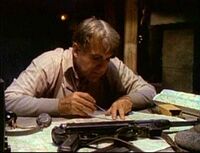
Claude, the leader of the Resistance cell Nick belongs to, plans their next action against the Germans.
The French Resistance is the collective name used for the French resistance movements which fought against the Nazi German occupation of France and the collaborationist Vichy Regime during World War II.
In 1942, Nick Knight is in Lyon working with a Resistance cell when one of their operations turns into a disaster. Several people are killed by the Germans; and only one escapes, mortally injured. Before he dies, Léo warns the cell's leader, Claude that they must have been betrayed by someone in the group; and Claude and Nick decide that the most likely traitor is a man called Giroux, whom neither of them considers wholly trustworthy, since he is a thief.

Nick sees Marie-Claire, a member of the Resistance cell, in the company of a German officer.
Giroux is questioned, but denies any involvement. Nick is aroused to fury by his insistence on his innocence; then, knowing the other man has seen his vampire side, he kills him. Claude is untroubled, since they would have executed Giroux anyway.
Later, however, Nick sees Léo's sister, Marie-Claire, in the company of a German officer. Sure that she must have been the real traitor, he attacks and drains her. Only then does LaCroix suggest, to Nick's horror, that it might be possible that she was actually romancing the officer to gain information to help the Resistance. Since she is now dead, there is, of course, no way to know for sure either way.
Motives for Resistance[]
For the first few years of the occupation (1940 to 1942), there was no real co-ordinated, organized resistance that fought throughout the whole of France. Active opposition was sporadic and carried out only by a tiny, disunited minority. Most French men and women held faith in the Vichy government and its patriarch Pétain, regarded as the "saviour" of France, and continued to do so until it became apparent that its unpopular policies amounted to collaboration with the German authorities. Indeed, initially after the fall of France, life continued normally for many French citizens.

German soldiers march through Paris after the fall of France.
However, conditions worsened. One of the terms of the Armistice that established Vichy was that France had to pay the costs of the German forces occupying the country. This amounted to twenty million Reichsmarks per day. Furthermore, an artificial exchange rate was established that effectively allowed German requisitions and purchases to be made into a form of organised plunder. As a result, there was soaring inflation that eventually resulted in endemic food shortages, and even malnutrition among the more vulnerable social groups. On top of that, hundreds of thousands of French workers were requisitioned and transferred to Germany for compulsory labour service. The occupation became increasingly unbearable with numerous regulations, censorship and propaganda in place during the day, and curfews at night.
Resistance Activities[]

The 30 September 1943 issue of the resistance newspaper Défense de la France.
The French resistance involved men and women of all ages, social classes, jobs, religions and political movements. The earliest resistance organisations had no contact with and received no material aid from London, and consequently most focused on propaganda through the distribution of underground newspapers. Many of the major movements grew around the distribution of the newspapers; and, although their activities gradually diversified over the following years, propaganda remained their most important occupation.
There were also resistance groups and networks created to collect intelligence, commit sabotage, and help Allied airmen who were shot down to evade capture by the Germans and escape from occupied Europe to continue the war. The intelligence networks were by far the most numerous and substantial of resistance activities, collecting information of military value to pass to the Allied Forces overseas, usually by radio.
Sabotage was undertaken by groups that wanted to take a more active role in resistance. The railways were a favourite target. Many laboratories were set up to produce explosives; dynamite was stolen from the Germans; and explosives were also parachuted in by the British Special Operations Executive. Guerrilla warfare was primarily undertaken by communists, who attacked German forces at the hearts of French cities.
The German occupation authorities and the collaborationist Vichy regime soon began employing increasingly brutal means in order to subdue the populace. In reprisal for resistance activity, the authorities established harsh methods of collective punishment. In particular, the increased militancy of communist resistance in August 1941 led to thousands of hostages being taken from among the general population, many of whom were shot as reprisals. Over the course of the occupation, some thirty thousand French civilians were shot as hostages for acts of resistance actually committed by other people.
The majority of resistance movements in France were unified after May 1943, when Jean Moulin formed the Conseil National de la Résistance (National Council of the Resistance). This coordinated with the Free French Forces. After the landings in Normandy and Provence, resistance combatants were organized more formally into units known as the French Forces of the Interior. Although this amalgamation was sometimes fraught with political difficulty, it allowed France to re-establish a reasonably large army by the time the war ended in May 1945.
- Adapted from the Wikipedia article on the French Resistance.